牛津小学英语unit4 教案
最新牛津译林版五年级英语下册Unit4Seeingthedoctor单元教案
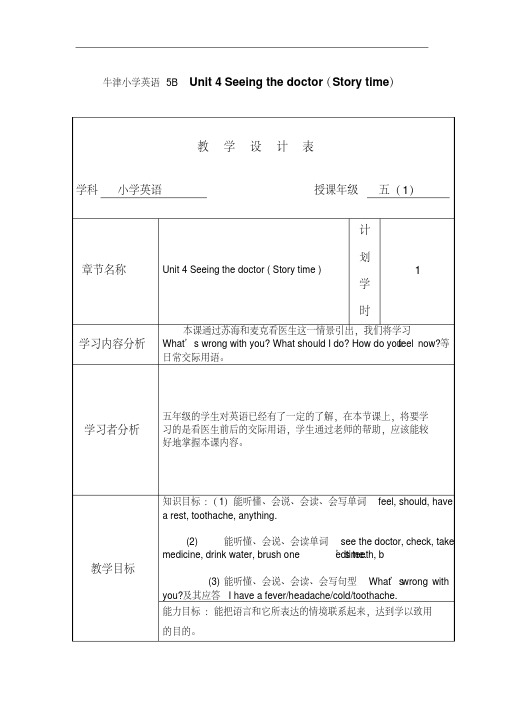
牛津小学英语5B Unit 4 Seeing the doctor(Story time)教学设计表学科小学英语授课年级五(1)章节名称Unit 4 Seeing the doctor ( Story time ) 计划学时1学习内容分析本课通过苏海和麦克看医生这一情景引出,我们将学习What’s wrong with you? What should I do? How do you feel now?等日常交际用语。
学习者分析五年级的学生对英语已经有了一定的了解,在本节课上,将要学习的是看医生前后的交际用语,学生通过老师的帮助,应该能较好地掌握本课内容。
教学目标知识目标:(1)能听懂、会说、会读、会写单词feel, should, have a rest, toothache, anything.(2)能听懂、会说、会读单词see the doctor, check, take medicine, drink water, brush one’s teeth, bedtime.(3)能听懂、会说、会读、会写句型What’s wrong with you?及其应答I have a fever/headache/cold/toothache.能力目标:能把语言和它所表达的情境联系起来,达到学以致用的目的。
情感目标:(1)激发学生的学习兴趣,培养学生乐于交流的好习惯。
(2)提示学生注意身体健康。
教学重点(1)能听懂、会说、会读、会写单词feel, should, have a rest,toothache, anything.(2)能听懂、会说、会读、会写句型What’s wrong with you?及其应答I have a fever/headache/cold/toothache.(3) 能正确理解和掌握本部分对话。
教学难点能掌握单词的发音及在现实生活中自如运用本单元的句型和日常交际用语。
Teaching process:时间活动版块活动内容与呈现方式学生活动方式交流方式5 min Step 1Warming-up1.Goals for this lesson.2.Free talkHow are you?I’m fine too. But Su Haiand Mike are not. Why?They are ill. What shouldthey do? 教授should的用法,并揭示课题Unit 4 Seeing the doctor.初步理解should, seethe doctor.(work in class)师生交流,引出本文的题材,吸引学生的注意力。
牛津小学英语3B_Unit4_Time_教案设计

牛津小学英语3B Unit4 Time 教案设计教学内容:Unit 4 Time (Part A 、B)教学目标:1、能正确地听、说、读、写数词one, two 及three 。
2、能听懂、会读数词1——12。
3、能听懂、会说以下日常交际用语:What ’s the time ? It ’s... It ’s time to... OK./All right.4、能模仿文中对话,并能在一定的语境中运用所学语言进行交际。
教学重点:1、重点句型Wha t ’s the time ?I t ’s ...It ’s time to...OK./All right.2、掌握本课出现的数词。
教学难点:1、three 的正确发音,seven 、 eleven 、 twelve 的辩别。
2、It ’s time ... 句型的用法。
教学准备:1、教具准备、多媒体课件、句型卡、游戏用手表、钟面模型。
2、板书准备:在黑板上划上钟面。
教学过程:A Free talk1、Sing a song 《ABC song 》.2、师生之间以What ’s your name ? I ’m... How are you? Fine,thank you.What ’s this ? It ’s a ...类似的话展开本课的Free talk.B Presentation and practice.1.呈现数字1、2、3、5、6、9、10、11(PPT2“What can you see?”)教师领读教学数词读音,学生跟读数遍,再板书。
在教单词时要请学生拼读并注意three 的发音th/θ/,看老师的口型。
2、呈现数字4、7、8、12。
(PPT3“What ’s missing ?”)请学生看黑板上的板书,观察少了哪几个数词并补充完整。
老师教学单词,学生分组读、个别读、齐读。
在读单词时要强调seven,eleven, twelve 的读音及写法。
2024年四年级英语上册Unit4Icanplaybasketball第三课时教案牛津译林版
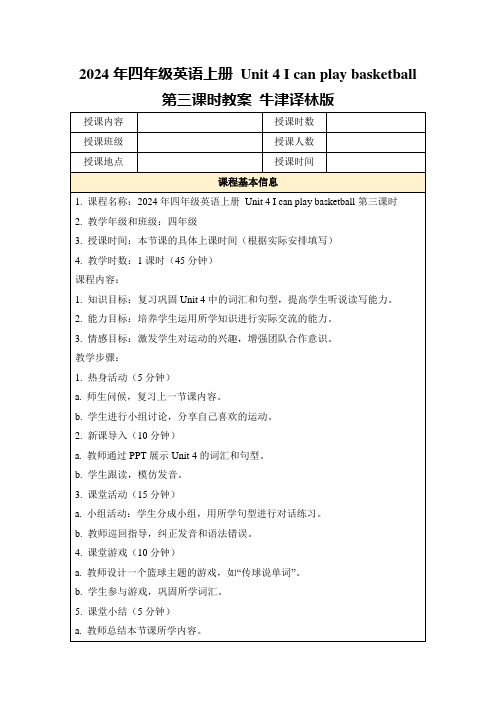
2.文化意识:本节课以运动为主题,引导学生了解和关注国内外运动文化,培养他们对运动精神的认同。同时,通过小组活动,让学生体验团队合作的重要性,增强跨文化交际意识。
最后,我还发现自己在课堂管理方面还有一些不足之处。为了提高课堂管理效果,我计划在未来的教学中加强课堂纪律的培养,同时也会更加注重学生的个体差异,给予每个学生足够的关注和支持。
教学评价与反馈
1.课堂表现:在课堂教学中,大部分学生能够积极参与,认真听讲,并主动回答问题。但也有少数学生在课堂纪律方面存在一些问题,如注意力不集中,容易与同学交谈。我会在课堂中加强对这些学生的关注,并适时提醒他们保持专注。
其次,我发现部分学生在运用can疑问句时还存在一些问题。为了提高学生的运用能力,我计划在未来的教学中增加更多的口语练习和角色扮演活动。通过让学生在实际情境中运用can疑问句,我相信他们的运用能力会有所提高。
另外,我还发现部分学生在课堂参与度上有所欠缺。为了激发学生的学习兴趣,我计划在未来的教学中增加更多的互动和游戏环节。我相信通过这些活动,学生能够更加积极地参与到课堂中来。
教学流程
一、导入新课(5分钟)
同学们,今天我们将要学习的是《I can play basketball》这一章节。在开始之前,我想先问大家一个问题:“你们平时喜欢运动吗?有没有最喜欢的运动项目?”这个问题与我们将要学习的内容密切相关。通过这个问题,我希望能够引起大家的兴趣和好奇心,让我们一同探索运动项目的英语表达。
3.确定教学媒体和资源的使用:
牛津小学英语2a教案 Unit4 Going about

牛津小学英语2a教案 Unit4 Going about一、教学目标1、能听懂、会说、认读单词:plane, train, taxi, car, bus, bike。
2、能听懂、会说日常交际用语:How do you go to…?及其回答 I go to… by…3、培养学生的英语听说能力和运用英语进行简单交流的能力。
二、教学重难点1、重点(1)掌握单词:plane, train, taxi, car, bus, bike 的正确发音和认读。
(2)熟练运用句型 How do you go to…?I go to… by…进行交流。
2、难点(1)单词 train 和 plane 的发音。
(2)理解并正确运用 by 表示出行方式。
三、教学方法1、情景教学法:创设真实的出行情景,让学生在情境中学习和运用语言。
2、游戏教学法:通过游戏激发学生的学习兴趣,巩固所学知识。
3、歌曲教学法:利用英语歌曲帮助学生记忆单词和句型。
四、教学过程1、 Warmup(1)GreetingsT: Hello, boys and girls!Ss: Hello, teacher!(2)Sing a song 《The wheels on the bus》教师带领学生一起唱歌曲,活跃课堂气氛,同时复习有关交通工具的单词。
2、 Presentation(1)Show pictures of different vehiclesT: Look! What can you see? (依次展示飞机、火车、出租车、汽车、公交车、自行车的图片)Ss: Plane / Train / Taxi / Car / Bus / Bike教师领读单词,注意纠正学生的发音,特别是 train 和 plane 的读音。
(2)Practice the wordsGame 1: What's missing?教师展示多张交通工具的图片,然后快速隐藏其中一张,让学生说出消失的图片是什么。
牛津小学英语4B Unit4 Part A 教案
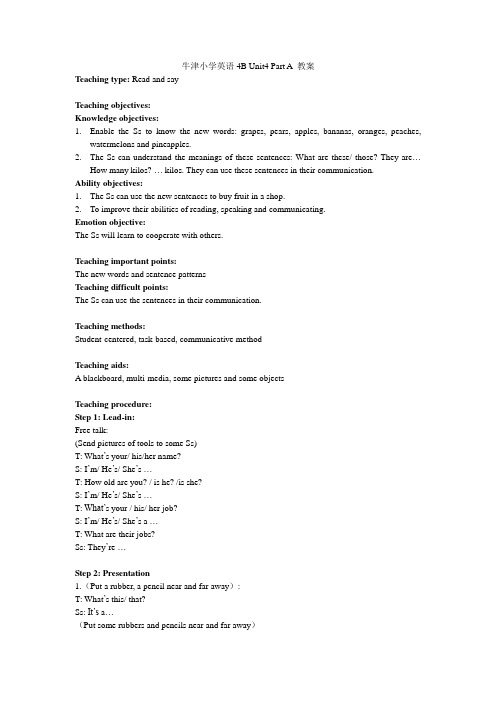
牛津小学英语4B Unit4 Part A 教案Teaching type: Read and sayTeaching objectives:Knowledge objectives:1.Enable the Ss to know the new words: grapes, pears, apples, bananas, oranges, peaches,watermelons and pineapples.2.The Ss can understand the meanings of these sentences: What are these/ those? They are…How many kilos? … kilos. They can use these sentences in their communication.Ability objectives:1.The Ss can use the new sentences to buy fruit in a shop.2.To improve their abilities of reading, speaking and communicating.Emotion objective:The Ss will learn to cooperate with others.Teaching important points:The new words and sentence patternsTeaching difficult points:The Ss can use the sentences in their communication.Teaching methods:Student-centered, task-based, communicative methodTeaching aids:A blackboard, multi-media, some pictures and some objectsTeaching procedure:Step 1: Lead-in:Free talk:(Send pictures of tools to some Ss)T: What’s your/ his/her name?S: I’m/ He’s/ She’s …T: How old are you? / is he? /is she?S: I’m/ He’s/ She’s …T: What’s your / his/ her job?S: I’m/ He’s/ She’s a …T: What are their jobs?Ss: They’re …Step 2: Presentation1.(Put a rubber, a pencil near and far away):T: What’s this/ that?Ss: It’s a…(Put some rubbers and pencils near and far away)T: What are these/ those? They’re…Ss: They’ re rubbers./pencils.(Write the sentences on the Bb and teach the Ss to read them.)2. Play a guessing game(Cover parts of the pictures and let the Ss to ask or guess)What are these? /What are those?They’re…3.Let’s chant:These, these, what are these?Apples, apples, they are apples.Those, those, what are those?Grapes, grapes, they are grapes.(Boys read the former parts and girls the later parts.)4.I’d like…我想要…(I’d like a panda.)5.T: I’d like some oranges. I buy some oranges here. How many oranges?How many kilos?(公斤)Two kilos.(Teach the Ss to read : How many kilos? Two kilos.)T: I’d like some watermelons. How many watermelons? How many kilos?Five kilos.(Teach the Ss to read: How many kilos? Five kilos.)6.Say a chant:How many, how many, how many kilos?One kilo, two kilos, three kilos;Four kilos, five kilos, six kilos;Seven kilos, eight kilos, nine kilos;I’d like nine kilos.Step 3: Practice:1.T: Open your books to page 30. Read the dialogue in Part A and then answer these T/F Qs.1 Miss Li wants to buy some oranges and grapes. ( )2 Miss Li wants one kilo of grapes. ( )3 Miss Li wants three kilos of pears. ( )4 The man in the picture is a worker. ( )The keys: F F T F2.T: Fill in the blanks1. This is a . These are .2. That is a . Those are .3. Miss Li wants(想要) to buy kilos of pears.4. Miss Li wants(想要) to buy kilos of grapes.Step 4 : Consolidation1.Read the dialogue after the teacher.2.Read the dialogue in roles with your partners.3.Read it in roles. (Boys act as the farmer and girls act as Miss Li.)4.Show the title: Unit 4 Buying fruit5.Act how to buy fruit using the sentences:A: Can I help you?B: I’d like some …, please.A: How many kilos?B: … kilo(s), please.A: Here you are.B: Thank you.(They can use the pictures of fruit. Teacher and a student act firstly and then ask some pairs to act.)Step 5: Homework1. Read the dialogue after the tape.2. Act the dialogue out with your friends.Blackboard design:Unit 4 Buying fruitWhat are these?They’re…What are those?They’re…Reflections: 在整个教学环节中我借助图片、多媒体等教学辅助手段创设了轻松活泼的氛围。
苏教版牛津译林版小学英语一年级上册教案 Unit 4 Period 1-2

苏教牛津版一年级上册英语Unit 4 My bagthe first period一、教学内容Page 19 B.Look and learnPage 20 C.Sing a song二、教学目标1.能听懂、会说book、bag、pencil和pencil box的单数形式,发音准确。
2.学习歌曲A pencil,初步掌握歌曲韵律。
三、教学重难点正确朗读book、bag、pencil和pencil box的单数形式,发音准确,会说,能听懂。
四、教学过程A. Read after the tape教师播放B.Look and learn,学生初步跟读,结合书本图片,从读音和意思上感知新单词。
B.Presentation(1)T:Hello, boys and girls. Look, What’s this?Ss:A book.T: Yes, this is a book. How nice!教师将a book的图片贴上黑板,教学朗读,请学生领读、开火车读、齐读。
T: And what’s this?Ss:A bag.以相同方法教学a bag、a pencil和a pencil box(2)play games1)say and do教师请一学生说一样学习物品,如a book,请其他学生拿出相应的物品2)what’s missing?请学生任意选择拿三张图片,让学生看看哪张不在其中。
练习说、听单词!(3)Read after the tape 跟读巩固。
C.Sing a song朗读歌词,听歌曲,初步熟悉韵律。
D.Assign homework(1)听读B.Look and learn各五遍,家长签名。
(2)跟唱C.Sing a song三遍。
Unit 4 My bagthe second period一、教学内容Page 18 A.Learn to say二、教学目标1.听懂他人使用This is a…介绍文具,并能使用此句型向他人介绍自己的文具,语音语调正确。
沪教版牛津英语三年级上册Unit 4 My friends(教案)
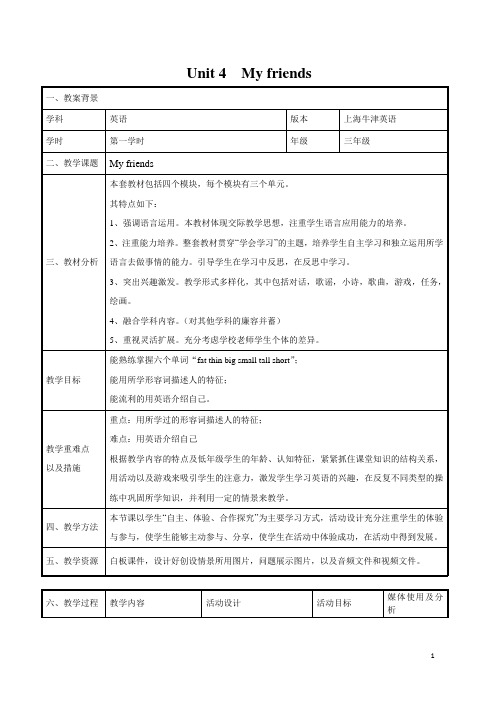
一、教案背景
学科
英语
版本
上海牛津英语
学时
第一学时
年级
三年级
二、教学课题
My friends
三、教材分析
本套教材包括四个模块,每个模块有三个单元。
其特点如下:
1、强调语言运用。本教材体现交际教学思想,注重学生语言应用能力的培养。
2、注重能力培养。整套教材贯穿“学会学习”的主题,培养学生自主学习和独立运用所学语言去做事情的能力。引导学生在学习中反思,在反思中学习。
b.Match the pictures and words
4.learn the boy/girl
1.Learn to introduce yourselves
a.Showthe picture of the cat and mouse.
b.Learn thepronunciations and meanings of the words by playing some games
五、教学资源
白板课件,设计好创设情景所用图片,问题展示图片,以及音频文件和视频文件。
六、教学过程
教学内容
活动设计
活动目标
媒体使用及分析
StepIPre-task preparation
Greeting.
T: Do you like to sing /
dance?
Let’s sing and dance.
幕布功能
插入了音频单词读音。
局部遮挡功能插入Leabharlann 音文件局部遮挡批注功能
StepIII Post-taskactivities
1.Introduce yourself
牛津译林版英语5上unit4教案
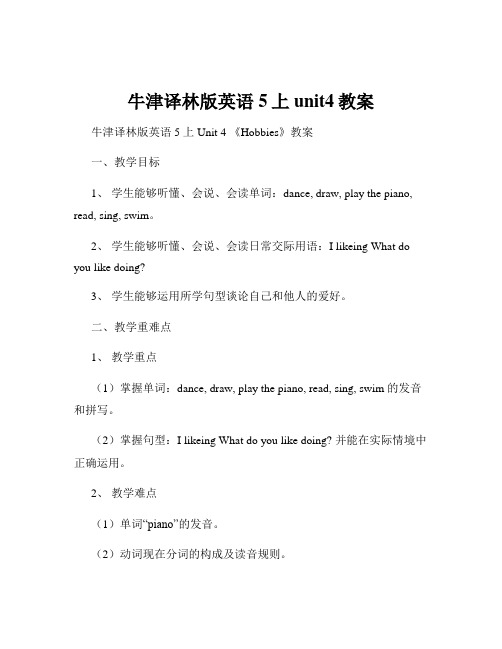
牛津译林版英语5上unit4教案牛津译林版英语 5 上 Unit 4 《Hobbies》教案一、教学目标1、学生能够听懂、会说、会读单词:dance, draw, play the piano, read, sing, swim。
2、学生能够听懂、会说、会读日常交际用语:I likeing What do you like doing?3、学生能够运用所学句型谈论自己和他人的爱好。
二、教学重难点1、教学重点(1)掌握单词:dance, draw, play the piano, read, sing, swim 的发音和拼写。
(2)掌握句型:I likeing What do you like doing? 并能在实际情境中正确运用。
2、教学难点(1)单词“piano”的发音。
(2)动词现在分词的构成及读音规则。
三、教学方法情景教学法、游戏教学法、任务驱动法四、教学过程1、 Warmup(1)GreetingsT: Good morning/afternoon, boys and girlsSs: Good morning/afternoon, teacher(2)Sing a songT: Let's sing a song together "The Finger Family"(师生一起唱英文歌曲,营造英语学习氛围)2、 Presentation(1)Show some pictures of hobbiesT: Look at these pictures What can you see? (展示一些关于爱好的图片,如跳舞、画画、弹钢琴、读书、唱歌、游泳等)Ss: I can see(2)Teach the new wordsT: Today we are going to learn some words about hobbies Look at this picture What is she doing? (展示跳舞的图片)Ss: She is dancingT: Yes, dance, dance, dance (教师领读,学生跟读)Repeat the same way to teach the other words: draw, play the piano, read, sing, swim(3)Practice the words① Game: What's missing?Show all the pictures and words on the PPT Then hide one of them Students guess what is missing② Do the actions and say the wordsTeacher does the actions of the hobbies and students say the words(4)Present the sentence patternsT: I like dancing What do you like doing? (教师做出跳舞的动作,并用句型介绍自己的爱好,引导学生回答)S1: I like drawingS2: I like reading(5)Practice the sentence patterns① Pair workStudents work in pairs and ask and answer about their hobbies② Group workStudents work in groups of four Each student says their hobbies and the others listen and repeat3、 Consolidation(1)Listen and repeatPlay the tape and students listen and repeat Pay attention to the pronunciation and intonation(2)Read in rolesStudents read the dialogue in roles(3)Make a dialogueStudents make a new dialogue about hobbies and act it out4、 SummaryT: Today we have learned some words about hobbies and the sentence patterns Who can tell me what we have learned? (学生回顾本节课所学内容)5、 Homework(1)Read the words and sentences five times(2)Ask your friends about their hobbies and write them down五、教学反思在本节课的教学中,通过图片、动作等多种方式呈现新单词和句型,激发了学生的学习兴趣。
- 1、下载文档前请自行甄别文档内容的完整性,平台不提供额外的编辑、内容补充、找答案等附加服务。
- 2、"仅部分预览"的文档,不可在线预览部分如存在完整性等问题,可反馈申请退款(可完整预览的文档不适用该条件!)。
- 3、如文档侵犯您的权益,请联系客服反馈,我们会尽快为您处理(人工客服工作时间:9:00-18:30)。
Unit 4Buying fruitPeriod 1Teaching content:part A12图 B C G3Teaching aims and difficulties:1. 能听得懂、会说、会读和会拼写单词apples, oranges, bananas, peaches, grapes, watermelons, pears。
能听得懂、会说、会读单词pineapples, lemons, strawberries, mangoes。
2. 能听得懂、会说、会读和会写句型What are these/those? They’re….3. 学会有表情的朗读歌谣《I like fruit》。
Teaching procedures:Step 1. Warming-upGreetings.Daily practise.T: Point to the teacher, student, policeman, nurse, doctor, dentist, farmer, etc.S: Teacher, student, policeman, nurse, doctor, dentist, farmer, etc.(do the action while speak out the word)T- S S- SStep 2. PresentationT: Do you like doctors/nurses/ policemen/ farmers/…?S: Yes, I do. ( No, I don’t.)T: Do you like your English/ Chinese/ math teacher?S: Yes, I do. (No, I don’t.)T: Thank you. Miss Wang likes apples. Do you like apples?S: Yes, I do. (No, I don’t.)T: What do you like, then?S: I like pears/bananas/pineapples/watermelons/peaches/oranges/mangoes. Step 3 New words, chant and structures learning1.New words learningT: Oh, I see. Now, I’ll play a game with you. It is called” Touch and guess”. Who’d like to come to the front and have a try?S: I try.T: XXX, come here. Please touch and guess what are these in the bag?S1: Pears.T: Let me see. Oh, you’re right. Now I’ll change the fruits, please wait a minute. OK, who’d like to try now?S: I try.T: XXX, you please.S2: (touching the fruits)T: What are these?S2: Oranges.T: I’m sorry you’re wrong. Who can touch and guess once again?S: I try.T: OK, XXX, you please.S3: Pears.T: I’m sorry you’re wrong, either. Let me show you: what are these in the bag? ( take out the fruits in the bag) Look, they’re lemons. Say after me, lemons.S: Lemons.T: Lemon. ( point to one lemon)S: Lemon.T: Lemons. ( point to all lemons)S: Lemons.T: OK, boys and girls. What are these in the bag?S: Lemons.T: Yes, you can also say: They’re lemons.S: They’re lemons.( Teach the words “grapes” and “ strawberries” in the same way.) T: OK, now let’s do ‘’point to …” once again, but this time we don’t point to the students act in different jobs, we point to the fruits. Are you ready?S: Yes.T: Good, here we go! Point to the lemons, grapes, strawberries, etc. S: Lemons, grapes, strawberries, etc.T-S S-S2. New chant learningT: You’ve done a great job just now. OK, it’s time to say a chant. Do you like it?S: Yes.T: OK. Listen to the tape carefully.(play the tape recorder)S: (Learn the chant)T: Now, let’s say the chant by ourselves. Strawberries, Strawberries, red and sweet. One, two, start!S: (Say the chant and clap their hands together.)3. New structures learningT: Very good! Excuse me, what are these in the bag once again?S: They’re lemons.T: Do you like lemons?S: Yes, I do. ( No, I don’t.)T: Thank you. Boys and girls, can you guess what are those behind the bookcase?S1: They’re lemons, too.T: No.S2: They’re oranges.T: No, you’re wrong. OK, I can give you a hint: they’re red and sweet. S3: They’re strawberries.T: Yes, how clever! You’re right. Do you like strawberries?S3: Yes, I do.T: Can you guess what are those behind the door? They’re yellow and sweet. S1: They’re pears.T: No.S2: They’re peaches.T: I’m sorry.S3: They’re mangoes.T: Bingo! You’re right. Do you like mangoes?S3: No, I don’t.Step 4. PracticeT: Now, please use the fruits you brought here to make a dialogue with your desk mates. If you didn’t bring anything, you can talk about the pictures on page 33 in your English book. Pay attention to use the new drills in your dialogues. Now, I’d like to give you an example. Please listen carefully. Excuse me, what are these?S4: They’re apples?T: Do you like apples?S4: Yes, I do.T: What are those over there?S4: They’re lemons.T: Do you like lemons?S4: No, I don’t.T: Oh, I see. I like lemons. May I have one?S4: Sure, here you are.T: Thank you.S4: Not at all.S: (Work in pairs.)T: Ask some pairs to act their dialogues out.T: Take out your books and turn to page 30, let’s read after the tape. S: (Read after the tape, and then read in groups/ pairs.)Step 5. ConsolidationT: I know my father and mother like apples. Do you know what fruit do you father and mother like? After class, use the words and sentences we have learnt today to ask your father and mother what do they like. If you don’t know how to say the fruits’ names, you can go and ask the greengrocers or bring them to the school and ask me. Then finish this table. Next class, I’ll check it out. That’s all for this class.HomeworkOral work: 1)Read the content on page 30 and 32 .2) Practise the chant on page 37 and try to make a similar one.3) Finish the table below:Fruits father mother grandfather grandmotherlikedon’t likeWritten work: Copy the new words and finish part E of the workbook. 教学反思:Period 2Teaching content:part A34图 DTeaching aims and difficulties:1. 能听得懂、会说、会读和会拼写单词some。
